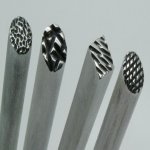It's an older European method of using a punch to impart a matte type (term?)finish onto a rifle receiver.
Was out for a stroll with a sportered 1891 yesterday and was wondering about a way to clean up the receiver where the Argentine crest was ground off.
The rifle is a fine piece of the gunmakers art...but will never be worth anything sadly.
I saw an article on it in Rifle Magazine...but darned if I know which one.
Any direction I should follow?
Was out for a stroll with a sportered 1891 yesterday and was wondering about a way to clean up the receiver where the Argentine crest was ground off.
The rifle is a fine piece of the gunmakers art...but will never be worth anything sadly.
I saw an article on it in Rifle Magazine...but darned if I know which one.
Any direction I should follow?
Last edited:











































































